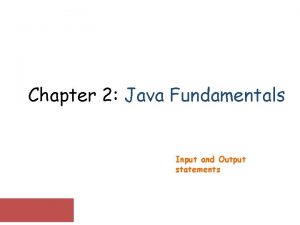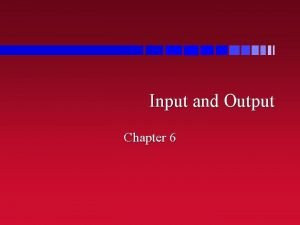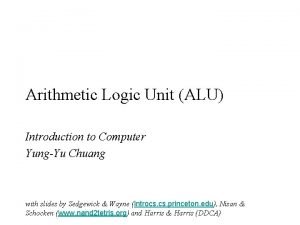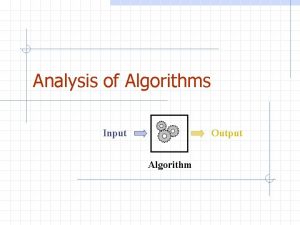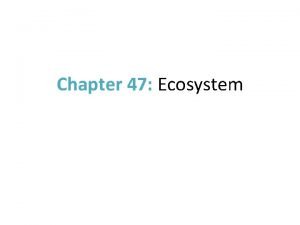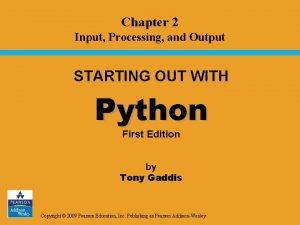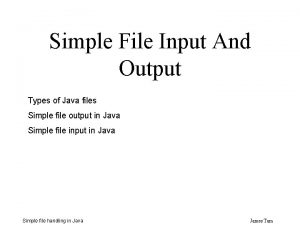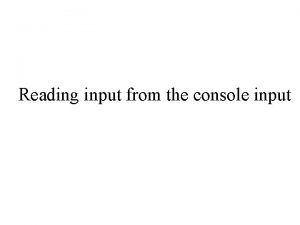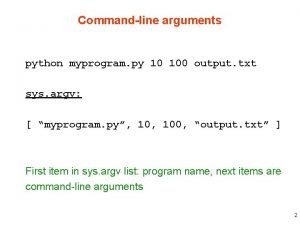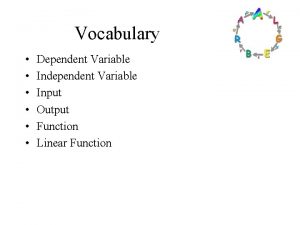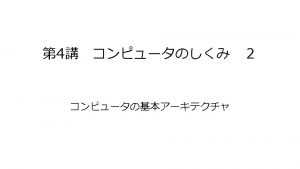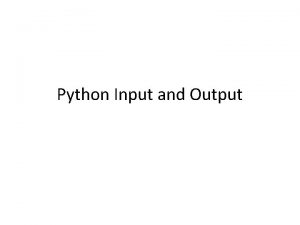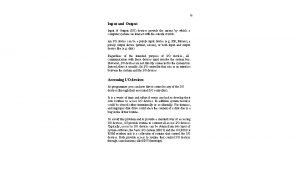Python Input and Output Copyright Software Carpentry 2010























































































- Slides: 87

Python Input and Output Copyright © Software Carpentry 2010 This work is licensed under the Creative Commons Attribution License See http: //software-carpentry. org/license. html for more information.

Been using print to see what programs are doing Python Input and Output

Been using print to see what programs are doing How to save data to files? Python Input and Output

Been using print to see what programs are doing How to save data to files? And read data from them? Python Input and Output

Been using print to see what programs are doing How to save data to files? And read data from them? Python's solution looks very much like C's Python Input and Output

Been using print to see what programs are doing How to save data to files? And read data from them? Python's solution looks very much like C's – A file is a sequence of bytes Python Input and Output

Been using print to see what programs are doing How to save data to files? And read data from them? Python's solution looks very much like C's – A file is a sequence of bytes – But it's often more useful to treat it as a sequence of lines Python Input and Output

Sample data file Three things are certain: Death, taxes, and lost data. Guess which has occurred. Errors have occurred. We won't tell you where or why. Lazy programmers. With searching comes loss and the presence of absence: "My Thesis" not found. A crash reduces your expensive computer to a simple stone. Python Input and Output

How many characters in a file? Python Input and Output

How many characters in a file? bytes Python Input and Output

How many characters in a file? bytes Python Assume 1 -to-1 for now Input and Output

How many characters in a file? bytes Assume 1 -to-1 for now Revisit later Python Input and Output

How many characters in a file? reader = open('haiku. txt', 'r') data = reader. read() reader. close() print len(data) Python Input and Output

How many characters in a file? reader = open('haiku. txt', 'r') data = reader. read() reader. close() print len(data) Create a file object Python Input and Output

How many characters in a file? reader = open('haiku. txt', 'r') data = reader. read() reader. close() print len(data) File to connect to Python Input and Output

How many characters in a file? reader = open('haiku. txt', 'r') data = reader. read() reader. close() print len(data) To read Python Input and Output

How many characters in a file? reader = open('haiku. txt', 'r') data = reader. read() reader. close() print len(data) Now holds file object Python Input and Output

How many characters in a file? reader = open('haiku. txt', 'r') data = reader. read() reader. close() print len(data) Read entire content of file into a string Python Input and Output

How many characters in a file? reader = open('haiku. txt', 'r') data = reader. read() reader. close() print len(data) Now has a copy of all the bytes that were in the file Python Input and Output

How many characters in a file? reader = open('haiku. txt', 'r') data = reader. read() reader. close() print len(data) Disconnect from the file Python Input and Output

How many characters in a file? reader = open('haiku. txt', 'r') data = reader. read() reader. close() print len(data) Disconnect from the file Not strictly necessary in small programs, but good practice Python Input and Output

How many characters in a file? reader = open('haiku. txt', 'r') data = reader. read() reader. close() print len(data) Report how many characters were read Python Input and Output

How many characters in a file? reader = open('haiku. txt', 'r') data = reader. read() reader. close() print len(data) Report how many characters were read bytes Python Input and Output

How many characters in a file? reader = open('haiku. txt', 'r') data = reader. read() reader. close() print len(data) 293 Python Input and Output

If the file might be large, better to read in chunks Python Input and Output

If the file might be large, better to read in chunks reader = open('haiku. txt', 'r') data = reader. read(64) while data != '': print len(data) data = reader. read(64) print len(data) reader. close() Python Input and Output

If the file might be large, better to read in chunks reader = open('haiku. txt', 'r') data = reader. read(64) while data != '': print len(data) data = reader. read(64) print len(data) reader. close() Python Read (at most) 64 bytes Input and Output

If the file might be large, better to read in chunks reader = open('haiku. txt', 'r') data = reader. read(64) while data != '': print len(data) data = reader. read(64) print len(data) reader. close() Python Read (at most) 64 bytes Or the empty string if there is no more data Input and Output

If the file might be large, better to read in chunks reader = open('haiku. txt', 'r') data = reader. read(64) while data != '': print len(data) data = reader. read(64) print len(data) reader. close() Python Keep looping as long as the last read returned some data Input and Output

If the file might be large, better to read in chunks reader = open('haiku. txt', 'r') data = reader. read(64) while data != '': print len(data) data = reader. read(64) print len(data) reader. close() Python Do something with the data Input and Output

If the file might be large, better to read in chunks reader = open('haiku. txt', 'r') data = reader. read(64) while data != '': print len(data) data = reader. read(64) print len(data) reader. close() Python (Try to) reload Input and Output

If the file might be large, better to read in chunks reader = open('haiku. txt', 'r') data = reader. read(64) while data != '': print len(data) data = reader. read(64) print len(data) reader. close() Should be 0 (or the loop would still be running) Python Input and Output

If the file might be large, better to read in chunks reader = open('haiku. txt', 'r') data = reader. read(64) while data != '': print len(data) data = reader. read(64) print len(data) reader. close() 64 64 37 0 Python Input and Output

If the file might be large, better to read in chunks reader = open('haiku. txt', 'r') data = reader. read(64) while data != '': print len(data) data = reader. read(64) print len(data) reader. close() 64 Don't do this unless 64 64 64 37 0 Python Input and Output

If the file might be large, better to read in chunks reader = open('haiku. txt', 'r') data = reader. read(64) while data != '': print len(data) data = reader. read(64) print len(data) reader. close() 64 Don't do this unless the file really 64 64 might be very large (or infinite) 64 37 0 Python Input and Output

More common to read one line at a time Python Input and Output

More common to read one line at a time reader = open('haiku. txt', 'r') line = reader. readline() total = 0 count = 0 while line != '': count += 1 total += len(line) line = reader. readline() reader. close() print 'average', float(total) / float(count) Python Input and Output

More common to read one line at a time reader = open('haiku. txt', 'r') line = reader. readline() Read a single line total = 0 count = 0 while line != '': count += 1 total += len(line) line = reader. readline() reader. close() print 'average', float(total) / float(count) Python Input and Output

More common to read one line at a time reader = open('haiku. txt', 'r') line = reader. readline() total = 0 count = 0 while line != '': Keep looping until count += 1 total += len(line) no more lines in file line = reader. readline() reader. close() print 'average', float(total) / float(count) Python Input and Output

More common to read one line at a time reader = open('haiku. txt', 'r') line = reader. readline() total = 0 count = 0 while line != '': count += 1 total += len(line) line = reader. readline() reader. close() print 'average', float(total) / float(count) Python (Try to) reload Input and Output

More common to read one line at a time reader = open('haiku. txt', 'r') line = reader. readline() total = 0 count = 0 while line != '': count += 1 total += len(line) line = reader. readline() reader. close() print 'average', float(total) / float(count) 19. 53333333 Python Input and Output

Often more convenient to read all lines at once Python Input and Output

Often more convenient to read all lines at once reader = open('haiku. txt', 'r') contents = reader. readlines() reader. close() total = 0 count = 0 for line in contents: count += 1 total += len(line) print 'average', float(total) / float(count) Python Input and Output

Often more convenient to read all lines at once reader = open('haiku. txt', 'r') contents = reader. readlines() reader. close() total = 0 count = 0 for line in contents: count += 1 total += len(line) print 'average', float(total) / float(count) Python All lines in file as list of strings Input and Output

Often more convenient to read all lines at once reader = open('haiku. txt', 'r') contents = reader. readlines() reader. close() total = 0 count = 0 for line in contents: count += 1 total += len(line) print 'average', float(total) / float(count) Python Loop over lines with for Input and Output

Often more convenient to read all lines at once reader = open('haiku. txt', 'r') contents = reader. readlines() reader. close() total = 0 count = 0 for line in contents: count += 1 total += len(line) print 'average', float(total) / float(count) 19. 53333333 Python Input and Output

"Read lines as list" + "loop over list" is common idiom Python Input and Output

"Read lines as list" + "loop over list" is common idiom So Python provides "loop over lines in file" Python Input and Output

"Read lines as list" + "loop over list" is common idiom So Python provides "loop over lines in file" reader = open('haiku. txt', 'r') total = 0 count = 0 for line in reader: count += 1 total += len(line) reader. close() print 'average', float(total) / float(count) Python Input and Output

"Read lines as list" + "loop over list" is common idiom So Python provides "loop over lines in file" reader = open('haiku. txt', 'r') total = 0 count = 0 Assign lines of text in file for line in reader: to loop variable one by one count += 1 total += len(line) reader. close() print 'average', float(total) / float(count) Python Input and Output

"Read lines as list" + "loop over list" is common idiom So Python provides "loop over lines in file" reader = open('haiku. txt', 'r') total = 0 count = 0 for line in reader: count += 1 total += len(line) reader. close() print 'average', float(total) / float(count) 19. 53333333 Python Input and Output

Python Input and Output

Put data in a file using write or writelines Python Input and Output

Put data in a file using write or writelines writer = open('temp. txt', 'w') writer. write('elements') writer. writelines(['He', 'Ne', 'Ar', 'Kr']) writer. close() Python Input and Output

Put data in a file using write or writelines writer = open('temp. txt', 'w') writer. write('elements') writer. writelines(['He', 'Ne', 'Ar', 'Kr']) writer. close() Same function Python Input and Output

Put data in a file using write or writelines writer = open('temp. txt', 'w') writer. write('elements') writer. writelines(['He', 'Ne', 'Ar', 'Kr']) writer. close() File to write to Python Input and Output

Put data in a file using write or writelines writer = open('temp. txt', 'w') writer. write('elements') writer. writelines(['He', 'Ne', 'Ar', 'Kr']) writer. close() File to write to Created if it doesn't exist Python Input and Output

Put data in a file using write or writelines writer = open('temp. txt', 'w') writer. write('elements') writer. writelines(['He', 'Ne', 'Ar', 'Kr']) writer. close() For writing instead of reading Python Input and Output

Put data in a file using write or writelines writer = open('temp. txt', 'w') writer. write('elements') writer. writelines(['He', 'Ne', 'Ar', 'Kr']) writer. close() Write a single string Python Input and Output

Put data in a file using write or writelines writer = open('temp. txt', 'w') writer. write('elements') writer. writelines(['He', 'Ne', 'Ar', 'Kr']) writer. close() Write each string in a list Python Input and Output

Put data in a file using write or writelines writer = open('temp. txt', 'w') writer. write('elements') writer. writelines(['He', 'Ne', 'Ar', 'Kr']) writer. close() elements. He. Ne. Ar. Kr Python Input and Output

Put data in a file using write or writelines writer = open('temp. txt', 'w') writer. write('elements') writer. writelines(['He', 'Ne', 'Ar', 'Kr']) writer. close() elements. He. Ne. Ar. Kr Python only writes what you tell it to Python Input and Output

Put data in a file using write or writelines writer = open('temp. txt', 'w') writer. write('elementsn') writer. writelines(['Hen', 'Nen', 'Arn', 'Krn']) writer. close() Have to provide end-of-line characters yourself Python Input and Output

Put data in a file using write or writelines writer = open('temp. txt', 'w') writer. write('elementsn') writer. writelines(['Hen', 'Nen', 'Arn', 'Krn']) writer. close() elements He Ne Ar Kr Python Input and Output

Often simpler to use print >> Python Input and Output

Often simpler to use print >> writer = open('temp. txt', 'w') print >> writer, 'elements' for gas in ['He', 'Ne', 'Ar', 'Kr']: print >> writer, gas writer. close() Python Input and Output

Often simpler to use print >> writer = open('temp. txt', 'w') print >> writer, 'elements' for gas in ['He', 'Ne', 'Ar', 'Kr']: print >> writer, gas writer. close() Specify open file after >> Python Input and Output

Often simpler to use print >> writer = open('temp. txt', 'w') print >> writer, 'elements' for gas in ['He', 'Ne', 'Ar', 'Kr']: print >> writer, gas writer. close() print automatically adds the newline Python Input and Output

Copy a file Python Input and Output

Copy a file reader = open('haiku. txt', 'r') data = reader. read() reader. close() writer = open('temp. txt', 'w') write(data) writer. close() Python Input and Output

Copy a file reader = open('haiku. txt', 'r') data = reader. read() reader. close() writer = open('temp. txt', 'w') write(data) writer. close() Python Read all Input and Output

Copy a file reader = open('haiku. txt', 'r') data = reader. read() reader. close() writer = open('temp. txt', 'w') write(data) writer. close() Python Write all Input and Output

Copy a file reader = open('haiku. txt', 'r') data = reader. read() reader. close() writer = open('temp. txt', 'w') write(data) writer. close() Probably won't work with a terabyte. . . Python Input and Output

Copy a file reader = open('haiku. txt', 'r') data = reader. read() reader. close() writer = open('temp. txt', 'w') write(data) writer. close() Probably won't work with a terabyte. . . …but we probably don't care Python Input and Output

Copy a file (version 2) Python Input and Output

Copy a file (version 2) reader = open('haiku. txt', 'r') writer = open('temp. txt', 'w') for line in reader: writer. write(line) reader. close() writer. close() Python Input and Output

Copy a file (version 2) reader = open('haiku. txt', 'r') writer = open('temp. txt', 'w') for line in reader: writer. write(line) reader. close() writer. close() Assumes the file is text Python Input and Output

Copy a file (version 2) reader = open('haiku. txt', 'r') writer = open('temp. txt', 'w') for line in reader: writer. write(line) reader. close() writer. close() Assumes the file is text Or at least that the end-of-line character appears frequently Python Input and Output

This version doesn't make an exact copy Python Input and Output

This version doesn't make an exact copy reader = open('haiku. txt', 'r') writer = open('temp. txt', 'w') for line in reader: print >> writer, line reader. close() writer. close() Python Input and Output

This version doesn't make an exact copy reader = open('haiku. txt', 'r') writer = open('temp. txt', 'w') for line in reader: print >> writer, line reader. close() writer. close() Python keeps the newline when reading Python Input and Output

This version doesn't make an exact copy reader = open('haiku. txt', 'r') writer = open('temp. txt', 'w') for line in reader: print >> writer, line reader. close() writer. close() Python keeps the newline when reading print automatically adds a newline Python Input and Output

This version doesn't make an exact copy reader = open('haiku. txt', 'r') writer = open('temp. txt', 'w') for line in reader: print >> writer, line reader. close() writer. close() Python keeps the newline when reading print automatically adds a newline Result is double-spaced output Python Input and Output

Copy a file (version 3) Python Input and Output

Copy a file (version 3) BLOCKSIZE = 1024 reader = open('haiku. txt', 'r') writer = open('temp. txt', 'w') data = reader. read(BLOCKSIZE) while len(data) > 0: writer. write(data) data = reader. read(BLOCKSIZE) reader. close() writer. close() Python Input and Output

Copy a file (version 3) BLOCKSIZE = 1024 reader = open('haiku. txt', 'r') writer = open('temp. txt', 'w') data = reader. read(BLOCKSIZE) while len(data) > 0: writer. write(data) data = reader. read(BLOCKSIZE) reader. close() writer. close() (Needlessly? ) harder to understand Python Input and Output

created by Greg Wilson October 2010 Copyright © Software Carpentry 2010 This work is licensed under the Creative Commons Attribution License See http: //software-carpentry. org/license. html for more information.
 Nnn design
Nnn design Principles of input output software
Principles of input output software Copyright 2010 pearson education inc
Copyright 2010 pearson education inc Copyright 2010
Copyright 2010 Copyright 2010
Copyright 2010 Copyright 2010 pearson education inc
Copyright 2010 pearson education inc Copyright 2010 pearson education inc
Copyright 2010 pearson education inc Copyright 2010
Copyright 2010 Nwoz
Nwoz Copyright 2010 pearson education inc
Copyright 2010 pearson education inc Copyright 2010 pearson education inc
Copyright 2010 pearson education inc Copyright 2010 pearson education inc
Copyright 2010 pearson education inc 2010 pearson education inc
2010 pearson education inc Copyright 2010 pearson education inc
Copyright 2010 pearson education inc Copyright 2010 pearson education inc
Copyright 2010 pearson education inc Pearson education inc all rights reserved
Pearson education inc all rights reserved Form design in system analysis and design
Form design in system analysis and design 4 automatic input devices
4 automatic input devices Types of virtual reality
Types of virtual reality Vat input
Vat input Input vs output vat
Input vs output vat Input vat and output vat
Input vat and output vat What is output
What is output Is a printer input or output
Is a printer input or output Conclusion for input and output devices of computer
Conclusion for input and output devices of computer Modern input devices
Modern input devices Advantages of input and output devices
Advantages of input and output devices Output devices notes
Output devices notes Output devices conclusion
Output devices conclusion The user output in hci is occurred through
The user output in hci is occurred through Computer science input and output
Computer science input and output Is system unit an output device
Is system unit an output device Output device
Output device Input of krebs cycle
Input of krebs cycle Vr input and output devices
Vr input and output devices Input and output of krebs cycle
Input and output of krebs cycle Input transformation output process
Input transformation output process Input and output devices wiring for plc
Input and output devices wiring for plc Specialized input devices examples
Specialized input devices examples Keyboard.nextstring
Keyboard.nextstring Is domain input or output
Is domain input or output Input devices
Input devices Output
Output Java input and output statements
Java input and output statements Input algorithm example
Input algorithm example Output knowledge
Output knowledge Conclusion of input and output devices
Conclusion of input and output devices Productivity = input/output
Productivity = input/output Chapter 6 input and output
Chapter 6 input and output Input devices
Input devices Alu input and output
Alu input and output How do you write an input and output algorithm?
How do you write an input and output algorithm? Vonnewman
Vonnewman Serial port of 8051 is
Serial port of 8051 is Peripheral input device
Peripheral input device 電腦五大單元
電腦五大單元 Quantity supplied vs supply
Quantity supplied vs supply Inputs to the citric acid cycle
Inputs to the citric acid cycle Energy input and output nutrition
Energy input and output nutrition Hardware input processing and output devices
Hardware input processing and output devices Hardware input processing and output devices
Hardware input processing and output devices Chapter 2 input processing and output
Chapter 2 input processing and output Java file input and output
Java file input and output Foramen interventriculare
Foramen interventriculare Console input and output in java
Console input and output in java Input/output
Input/output Input and output statement
Input and output statement Sensory input and motor output
Sensory input and motor output Input and output devices project
Input and output devices project Combination input and output devices
Combination input and output devices Input
Input Boiler input and output
Boiler input and output Roughly-tuned input definition
Roughly-tuned input definition Output python
Output python Input format python
Input format python An input validation loop is sometimes called
An input validation loop is sometimes called Direct input python
Direct input python Dependent variable
Dependent variable Io burst
Io burst Scanner as input device
Scanner as input device The ratio of input distance to output distance
The ratio of input distance to output distance Limitations of the study examples
Limitations of the study examples Perkakasan input
Perkakasan input Laser printer output device
Laser printer output device Input, proses, output outcome kesehatan
Input, proses, output outcome kesehatan Ipo research paradigm
Ipo research paradigm Input output organization
Input output organization The keyboard mouse scanner digital camera or
The keyboard mouse scanner digital camera or











































